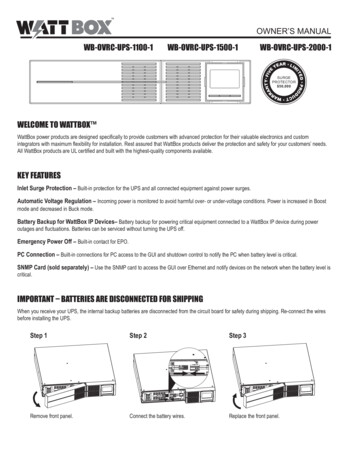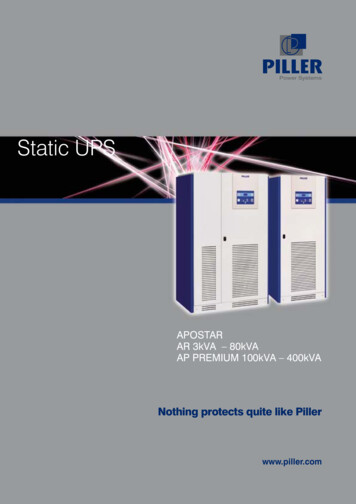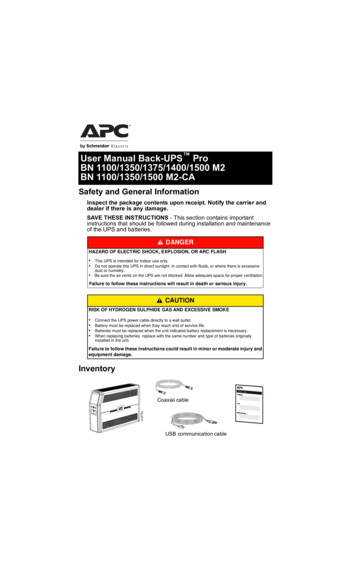
Transcription
The Reliability of the Individual UPSStill an issue?Dipl.-Ing. Frank Herbener, Piller Group GmbH,Frank.Herbener@Piller.com, GermanyWhite Paper No. 054Revision 0from 22.02.2010
Contents1Introduction .32Reliability of individual UPS systems .432.1The terms MTBF and MTTR .42.2The difference between MTBF and availability .52.3Importance of large numbers .62.4Components and design .72.5Maintenance and service life of components.72.6Redundancy.92.7The importance of monitoring components and functions .10Reliability of systems .113.1Parallel connection of UPS systems.113.2Parallel structures within UPS systems .123.3Calculation of reliability figures with the aid of block diagrams .133.4Influence of common components.163.5Comparison of redundant UPS configurations .174Summary.215References .22WP054 – 0The Reliability of the Individual UPSPage 2 of 22
1 IntroductionReliability is a device characteristic and describes the probability of a piece of equipment orsystem fulfilling the required functions under given conditions and during a given time period.For an uninterruptible power supply system (UPS), reliability means an uninterrupted supplyto the loads at a predetermined voltage quality.Today, complex arrangements of several UPS systems achieve a very high degree ofreliability. They ensure that a fault in one or sometimes several UPS systems does not alsolead to a failure of the supply to the secure busbar. This is guaranteed by a redundantsystem configuration. Redundancy can be realized in different ways by parallel connection toa common bus or by a combination of independent units with some multiple redundancy. Itraises the question: does the reliability of the individual UPS systems still have an importantinfluence on system reliability or is this only determined by the system configuration? Werethe latter to be the case then, nevertheless, highly-reliable systems could be built with anappropriate number of "unreliable" and "cheap" UPS modules. It will be shown that this is nottrue, rather that the individual systems have a decisive influence on system reliability in allconfigurations.WP054 – 0The Reliability of the Individual UPSPage 3 of 22
2 Reliability of individual UPS systemsExamination of the reliability of individual UPS systems assumes examination of theindividual possibilities of failure and the probability of their occurrence. The following sectionsprovide an overview of the various terms and their significance to the reliability calculation.2.1The terms MTBF and MTTRThe terms MTBF and MTTR refer to repairable systems in which a fault can be repaired andfollowing repair, the unit is able to carry out its function again under the given conditions. Themean time between two failure periods, i.e. the failure-free operating time, is termed "meantime between failures" (MTBF). The mean time during which the unit is inoperative is the"mean down time" (MDT). This time includes the mean repair time, denoted by the term"mean time to repair" (MTTR). In the literature and in calculations the term MTTR isfrequently used instead of MDT. The time from fault occurrence to fault occurrence is thengiven by the sum of MTBF plus MTTR. The MTBF is usually several orders of magnitudelonger than the MTTR.If a part or a functional module in a system is redundant, it can fail without the essentialfunction of the entire system failing. But it must be repaired or replaced before the redundantpartner also fails. Due to the fact that the MTBF is usually much greater than the MTTR, theprobability of a double failure is very low. Consequently, a system with built-in redundancyhas considerably higher reliability compared to one without redundancy.Redundancies can be built into units and also realized in systems incorporating several unitstogether.uptimedowntimetdowntimereaction-time repair-timeMTBFMTTRtFigure 1WP054 – 0Reliability termsThe Reliability of the Individual UPSPage 4 of 22
2.2The difference between MTBF and availabilityAvailability A is used in addition to MTBF as one of the characteristic values for the degree ofreliability. It is defined by the ratio of MTBF to total time MTBF MTTR, soA MTBFMTBF MTTR(1)Whereas MTBF is directly related to the failure rate (failure rate λ 1/MTBF), and thereforesays something about the absolute frequency of the fault, availability is a measure of theusability period of the unit in relation to the total time and says nothing about the absolutefailure rate.A clear distinction must therefore be made between these variables.Availability is usually represented in the form 0.9999 . Frequently, only the number of ninesafter the decimal point is stated, where many nines are usually associated with a highlyreliable system. But the availability still says nothing about the mean frequency of theoccurrence of faults and different pairs of MTBF and MTTR can result in identical availabilityvalues. Figure 2 shows examples of different failure rates of 10 years, 1 month and 1 day,which result in correspondingly graded failure times of 1 hour, ½ minute and 1 second for thesame availability A 0.99988.Same Availability of A 0.99998843 (4 nines)Figure 2MTBF 10 yearsMTTR 1hMTBF 1 monthMTTR 30sMTBF 1 dayMTTR 1s Different MTBF values for the same availabilityIt is obvious that for an IT application the last case would certainly lead to serious problems,whereas the first case is clearly more acceptable.WP054 – 0The Reliability of the Individual UPSPage 5 of 22
2.3Importance of large numbersThe time period that is necessary for the repair of a unit (MTTR) normally varies in the regionof hours or days. This time is counted from the moment the failure occurs up to the point atwhich the unit is returned to the functioning status and includes reaction and travel times ofthe service personnel, as well as the actual repair and also the test times.The usable time (MTBF) varies between several tens and hundreds of thousands of hours,that is to say several years, and values of some hundred years can be assumed forredundant systems. These values are purely statistical figures and the MTBF must nottherefore be mistaken for the service life of a system. An individual system may possibly notfail at all during its service life, others perhaps several times. The statement of an MTBFvalue of one million hours ( 114 years) should be taken to mean, for example, that, within agroup of 1000 equivalent units, one unit can be expected to fail every 1000 hours ( 6weeks). From this viewpoint an increase in the MTBF from one million to 1.2 million hours,for example, definitely represents a meaningful improvement. In the example given above,the (statistical) interval between two failures would consequently be extended to 7 weeks.2.4Components and designThe reliability of a UPS system is based on the reliability of its components, where their tasksand the importance of their function within the module are also of significance. One of themain problems for the UPS manufacturer is therefore to choose and incorporate suitablecomponents which can reliably and permanently fulfil their function in the UPS system, giventhe constraints imposed.Here the main task that falls to the developer is to select the correct components from thepoint of view of functional suitability and the expected environmental conditions. In addition tosuitable dimensioning for nominal operation, it is sensible to allow a margin for the key dataof the components in order to improve reliability, so that for overload or overvoltageconditions, for example, the reliability data do not have to be downgraded or componentsexposed to premature ageing.The environmental conditions for which the UPS system has been designed are described inthe data sheet in the form of tolerance ranges. However, the conditions for individualcomponents within the unit may possibly deviate from these. This applies, for example, tolocal operating temperatures to which individual components can be exposed according toWP054 – 0The Reliability of the Individual UPSPage 6 of 22
their cooling conditions and the influence of neighbouring components. Apart from carefuldesign which is based, not least on the manufacturer's experience, all possible applicationsof a UPS system must therefore be considered and thoroughly tested in order to guaranteeits reliable operation later on.2.5Maintenance and service life of componentsRedundant UPS systems allow faults in individual modules without the entire system losingits functionality. The probability of a double fault which could result in the interruption of thesecure power supply to the load increases with the MTTR of the module, i.e. with thenecessary mean time to repair. The same also applies to service work on components whichrequire regular maintenance, such as fans or capacitors, for example, since also during thistime the unit is not available to the system. The construction of the UPS system shouldtherefore be of a type that allows repair and maintenance operations to be carried out withonly short down-times. The maintenance intervals also determine the frequency ofshutdowns, which in turn influence the mean down-time. An extension of the maintenanceintervals can be achieved for example by increasing the service life of the relevantcomponents to a maximum. This is achieved, for example, by lower utilization and lowoperating temperatures. Ideally, components are used which require no regularmaintenance, which is the case for example if chokes are used instead of capacitors in filtercircuits, provided that this is allowed by the system concept.Incidentally, experience shows that faults often occur in a UPS system during or after workon the individual units. Also in this respect the selection of low-maintenance componentsleads to an increase in reliability of the individual UPS units and consequently that of thesystem as well.Frequent mention is made of a critical fault when the required function is no longer fulfilled,i.e. when in the case of a UPS system the supply to the load is no longer guaranteed. Formany technical units, especially standard equipment, the failure rate (λ 1/MTBF), that is tosay the number of faults per time, is represented by a so-called bathtub curve. Figure 3shows the basic characteristic.WP054 – 0The Reliability of the Individual UPSPage 7 of 22
Random failures with aconstant failure rate λTesting andCommissioningWear-outfailuresFailure rateWear-infailuresTolerable / acceptablefailure rateTimeoperating time bStartFigure 3Maintenance requiredTypical characteristic curve of the failure rate of technical systems(Bathtub curve)Following the commissioning of a piece of equipment, its failure rate is initially relatively high.This period is denoted "burn-in" and should elapse before the component is used for theactual function. This usually happens during the test and commissioning phase. A longertime interval with virtually constant and low failure rates over the service life of the productfollows the "burn-in" phase. At the end of the service life the fault rate rises again due to weareffects.The time at which maintenance occurs or the end of the useful life of the components isdetermined by the tolerable or acceptable failure rate. All reliability calculations are based onthe constant failure rate in the central region of the curve.For the reliability calculation following a repair or component replacement, it is assumed thatthe failure rate is again located at the bottom of the bathtub curve. At the same time,replacement parts must have passed through the "burn-in" phase. In addition, trouble-freeoperation of the replacement part inside the equipment should be ensured by appropriatetests, before the UPS system is again finally put into service. So-called "plug-in" solutions, inwhich individual components are required to be immediately fully functional without a finaltest, are questionable for high-reliability systems.WP054 – 0The Reliability of the Individual UPSPage 8 of 22
2.6RedundancyRegarding its reliability, apart from a low component failure rate, internal functionality is thesecond most important characteristic of a UPS system and is particularly reflected in itsreaction to the failure of individual components. Failure-tolerant performance exists if, in theevent of a component failure, it is possible to switch over to a reserve component or areserve group, without the supply to the load being interrupted at the same time. In the endthis leads to the term redundancy which describes the state of readiness of parallelbranches. In UPS systems, specific redundant or partially-redundant branches are usuallyprovided, such as the bypass path for example, which in the event of a failure of one of themain components makes it possible to continue operation – even if with limited functionality.The mode of operation of a redundant function will now be explained by means of theexample of the diode function (Figure 4). With an individual diode, an internal short-circuit oropen-circuit inevitably leads to malfunction. A series circuit of two diodes controls the shortcircuiting of one diode without outwardly impairing the overall functionality, whereas an opencircuit results in failure. A parallel circuit of two diodes controls the open-circuit of one diode,whereas now the short-circuit leads to failure. Full redundancy for both cases of failure isonly possible by means of a circuit having four diodes, by connecting two groups of twoseries-connected diodes in parallel.Figure 4Different types of redundancyThe prerequisite for practical, redundant operation is a system that is capable of beingrepaired. Moreover, it is imperative that the faulty component is reliably detected by theinternal monitoring functions to facilitate its replacement before a further fault occurs.This principle can be applied to the redundant operation of UPS systems. In the event of afailure in the inverter of a UPS, the function of an open circuit is undertaken by a parallelconnected branch, in this case the redundant UPS, whereas a short-circuit must initially betransferred to the open-circuit state with the aid of fuses or fast electronic switches.WP054 – 0The Reliability of the Individual UPSPage 9 of 22
An individual UPS system does not usually contain any redundant branches of numerousidentical components. Where available, the bypass branch offers redundancy with limitedfunctionality. This is termed pseudo redundancy. In static systems this branch is providedinternally or externally anyway for continued supply to the load in the case of overloads andshort-circuits, so that additional components are not even necessary for redundancy in thiscase. Therefore full redundancy is not obtained since, in the bypass mode, the unregulatedmains is connected to the load.In many UPS systems the control power supply draws its energy from two or moreindependent sources, e.g. from the mains and the battery, which, at least during mainsoperation, represents true redundancy.2.7The importance of monitoring components and functionsAs already mentioned above, redundancy requires monitoring of the redundant elements. Onthe one hand this is necessary in order to shut down faulty branches and if necessaryactivate parallel paths, and on the other hand it facilitates the repair of the defective partbefore another part fails. Improved reliability through redundancy is only possible because ofthis.In addition, however, this monitoring also prevents serious damage to components bydeactivating them in time when in a critical operating state. This helps to avoid unnecessaryrepair times and the costs related to the repairs.WP054 – 0The Reliability of the Individual UPSPage 10 of 22
3 Reliability of systems3.1Parallel connection of UPS systemsUPS systems with major power ratings can usually be connected in parallel to form largegroups. The main reason for this is to increase the output power. If in such a parallel groupall units are required to supply the load, it is obvious that with an increasing number of UPSsystems the probability of a failure increases. As can be seen in Figure 5, the MTBF value ofthe entire group falls as 1/n, where n represents the number of UPS systems participating inthe group. With six parallel units the system has a remaining MTBF value of only 16.7percent of the value of the individual unit and thus a failure rate which is six times higher.System Reliability of Paralleled UPS(related to the reliability of the single unit)100%Relative System umber of Paralleled UPSFigure 5System reliability of power-parallel UPS units.Instead of the parallel connection of many small units, the use of larger modules thereforerepresents a better solution. Referring to the ultimate configuration, this is usually the mosteconomical variant.The second reason for parallel connection is the introduction of a redundant component.Very often both cases are combined and represent a system of the form n 1. The redundantunit considerably increases the reliability through an increase in the MTBF value. But whatequally applies here is that the reliability falls with the increasing number n of parallel units.The relationship is noticeable for the fact that the redundant unit ( 1) must remain availableto all remaining n units. Figure 6 figure shows a calculation up to n 7.WP054 – 0The Reliability of the Individual UPSPage 11 of 22
System-MTBF of n 1 redundant configurationsSystem-MTBF in mill. h25000200001500010000500001 1Figure 62 13 14 15 16 17 1System reliability of redundant-parallel units.It is therefore also true for redundant UPS systems that in relation to reliability large UPSmodules are the preferred choice.3.2Parallel structures within UPS systemsParallel connections are also realized within UPS systems. This is usually used to increasepower. Within so-called modular UPS systems this method can also be used to achieveredundancy in case of under-utilization. Non-redundant internal parallel connections arefrequently found in the power modules and capacitors of static converters to obtain the targetpower output of the module. In comparison, other components such as transformers andchokes, for example, can be designed for high power without the necessity of parallelconnections, which has a positive effect on reliability. The same applies to electricalmachines which are used in rotating UPS systems.In the above-mentioned modular UPS systems, several individual modules can be paralleledin one housing using withdrawable unit design, to give the external appearance of one UPSsystem. In these systems I/O areas, and also to some extent the control and the bypass arecommonly used.The relationship illustrated above, where the reliability of the entire system falls off sharplywith the number of units connected in parallel, likewise applies to each type of internalparallel connection.WP054 – 0The Reliability of the Individual UPSPage 12 of 22
3.3Calculation of reliability figures with the aid of block diagramsReliability block diagrams (RBD) are a suitable method for calculating system reliability. Eachblock corresponds to a functional unit within a UPS or to a complete unit. Mains, batteries,switchgear, communications devices and, if necessary, transfer switches need to beincluded. Corresponding values for MTBF and MTTR, taken from previous calculations,manufacturer's data or out of field experience, are assigned to each block. The structure ofthe block diagram states which blocks must be intact so that the overall function is fulfilled.Redundancies are accounted for by parallel structures.Two examples are described below. In the first one, shown in Figure 7, the load is sharedbetween two units A and B, that is to say both units are required for the supply. In theassociated RBD this fact is represented by a series connection of the blocks. As an ANDfunction, both blocks must be intact so that the output is totally intact.Electrical ConfigurationUPS 1100 kVAReliability Block DiagramUPS 2100 kVABlockBMTBF: mA mB 200.000 hMTTR: rA rB 24 hLoad 200 kVAFigure 7BlockASchematic and reliability block diagram (RBD) of power-parallel unitsThe interrelationships in the entire system become clear if the time sequences of the twoUPS units are represented with intact and failure times, like it is shown in Figure 8. Eachfailure of one individual unit causes the entire system to fail.UPS 1UPS 2SystemFigure 8WP054 – 0Effect of faults in a power-parallel configurationThe Reliability of the Individual UPSPage 13 of 22
The reliability values MTBF and MTTR resulting from the series connection of the blocks canbe obtained using the following formulas, where m stands for MTBF and r for MTTR:m A mB 100.000 hm A mB(2)m A rB mB rA 24 hm A mB(3)mS rS This example shows that the resulting MTBF is half the MTBF value of the individual blockkeeping the MTTR the same.With the redundant-parallel configuration in the second example, shown in Figure 9, one unitis sufficient to supply the load. In the RBD this is illustrated by a parallel arrangement of theblocks, which represents an OR function. If A or B is intact, then the output is intact.Electrical ConfigurationUPS 1100 kVABlockABlockBUPS 2100 kVALoad 100 kVAFigure 9Reliability Block DiagramMTBF: mA mB 200.000 hMTTR: rA rB 24 hSchematic and reliability block diagram (RBD) of redundant-parallel unitsHere again the interrelationships between the time sequences are clear (Figure 10); theexemplifying failure times of units A and B in Figure 8 and Figure 10 remaining identical.UPS 1UPS 2SystemFigure 10WP054 – 0Effect of faults in a redundant-parallel configurationThe Reliability of the Individual UPSPage 14 of 22
In this case the reliability values for the system are:mSystem m A mB (m A rB mB rA ) 833.000.000 hrA rB(4)rA rB 12 hrA rB(5)rSystem This result clearly shows how great the influence of redundancies can be on the overallsystem.If a block diagram contains more than two blocks, the above rules can often be appropriatelycombined for the parallel- and series-connected blocks and a result for the whole system canbe obtained in this way. The blocks cannot be combined in the case of complex, overlappingstructures. In these cases, calculation requires special software which determines thesolution with the aid of Boolean algebra.The following interesting relationship can be established with the redundant-parallelconnection. In formula 4 for the system's MTBF value, compared to the first product themuch smaller expression in brackets can be ignored and the formula can be reduced to:mSystem m A mBrA rB(6)Assuming the same reliability data m m A mB and r rA rB for both of the units A and B,the formula is simplified to:mSystem m22 r(7)It can be deduced from this that the MTBF value of the individual redundant blocks issquared in the system reliability, i.e., a doubled MTBF value for the individual UPS results ina four times higher MTBF value for the redundant-parallel system. Figure 11 shows thesystem MTBF versus the MTBF of the individual unit for the 1 1 configuration.WP054 – 0The Reliability of the Individual UPSPage 15 of 22
System-MTBF as a function of Unit-MTBFin an 1 1 redundant configurationSystem-MTBF in mill. h2500020000150001000050000100.000Figure 11300.000 500.000 700.000Unit-MTBF in hrs900.000Dependency of the system MTBF on the unit MTBFIn comparison, the repair times (MTTR) of the units are only in a linear relationship to thesystem MTBF, so halving them produces a doubling of the MTBF.3.4Influence of common componentsCalculation of the system reliability using block diagrams assumes total independency of theindividual blocks. Consequently, no mutual fault influence shall occur. By comparison, in realparallel connections of UPS systems as well as inside modular UPS units, commonelements, such as the communications bus between the UPS units and the common loadbusbar, are to be found. Added to these are possible influences between the units, whichresult from faults in one of the units and which can have lasting negative effects on thecontinued trouble-free parallel operation of the healthy units, for example through false ordefective protocols on the communications bus or failure to isolate the load bus in the eventof a fault.These common elements are described as "single point of failure". They are taken intoaccount in the block diagram by elements connected in series, as shown in Figure 12.UPS 1LoadbusCommunicationUPS 2Figure 12WP054 – 0Common components in the reliability block diagramThe Reliability of the Individual UPSPage 16 of 22
3.5Comparison of redundant UPS configurationsIn the following, the four most important configurations of redundant UPS Systems arecompared to show how their reliability is affected by the MTBF values of the individual units.Table 1 gives an overview of the types of connections under consideration.ConnectionRedundancy Common or additional elements1Redundant-paralleln 1Communications bus, busbar2Isolated-redundantn 1Static transfer switch3Isolated-paralleln 1Power circuit-breakers, chokes4System-system-redundantn nNoneTable 1Redundant UPS systems under considerationThe redundant-parallel connection (Figure 13) utilizing a common busbar at the output is aclassic method. In the n 1 redundant system there is one more unit than would be requiredto supply the load. Common elements are the common busbar and the communications bus.321CommunicationLoadsFigure 13Parallel Bus121323Com. Com. Com.Loads321Circuit diagram and RBD of a Parallel Redundant UPS-SystemThe isolated-redundant connection (Figure 14) avoids these common elements, butadditionally requires fast transfer switches (STS) which, in the event of a fault in one UPSsystem, connect the load to the separate redundant unit.STS STS1.1 1.2STS STS2.1 2.2Load 1Figure 14WP054 – 0321Load 2Circuit diagram and RBD of a Isolated Redundant UPS-SystemThe Reliability of the Individual UPSPage 17 of 22
A relatively new layout is the Isolated-Parallel System (Figure 15) consisting of independentindividual units each connected to its assigned load. In this configuration the units areinterconnected via chokes with virtually no interaction. All units are dimensioned so that inthe event of a fault in one unit the remaining units can supply its load via the chokes (C) andthe so-called IP-Bus.IP-BusC1Load 1Figure 15212C1 C3D313C1 C3D223C1 C3D132131IP-ChokeC2Load 2C3Load 3Load 1andLoad 2andLoad 3Circuit diagram and RBD of a Isolated Parallel UPS-SystemThe fourth variant represents two separate systems, each of which consists of one group ofpower-parallel units (Figure 16). The loads are supplied by each group via their respectivebusbar. There are no common elements between the two UPS groups, but the loads must beable to be connected to both supply rails without interaction, which then producesredundancy for the infeed. A typical load for this type of UPS-System are servers whosepower supply units are equipped with two independent feeders.321Bus A4Bus B1234Load(A or B)LoadFigure 16WP054 – 0Circuit diagram and RBD of a System Redundant UPS-SystemThe Reliability of the Individual UPSPage 18 of 22
The following calculations show the effect of the MTBF of the individual unit on theSystem-MTBF of the various configurations. The assumed values in Table 2 serve as a basisfor the system reliability calculations:UPS block powerS100 kVAConsumer loadS200 kVARepair time for all elementsMTTRReliability of the single unittypical Static UPS:typical Rotary UPS:MTBF24 h200.000 h1.000.000 hReliability of communications bus and shut-down measuresMTBF50 Mill. hReliability of static transfer switches STSMTBF150.000 hChokeMTBF60 Mill. hShut-down measuresMTBF60 Mill. hReliability of choke and shut-down measures in the isolatedparallel connectionTable 2Common data for exemplifying calculationsThe layout of the redundant configurations and the associated reliability block diagram areshown in Figure 13 to Figure 16. The results are shown in Table 3.single unit MTBF:Typredundancy200,000 h1,000,000 hsystem MTBFsystem MTBF1. redundant parallel2 115.7 mill. h16.6 mill. h2. isolated redundant2 151 mill. h118 mill. h3. isololated parallel2 1274 mill. h6511 mill. h4. system-system redundant2 2208 mill. h5209 mill. hTable 3Dependency of the System MTBF on the single unit MTBF.In all configurations the results show the obvious effect of the MTBF of the individual unit onthe system MTBF. Because of the common elements in the redundant-parallel system (1) theeff
Frank Herbener, Piller Group GmbH, Frank.Herbener@Piller.com, Germany White Paper No. 054 Revision 0 from 22.02.2010 . WP054 - 0 The Reliability of the Individual UPS Page 2 of 22 . of a UPS system must therefore be considered and thoroughly tested in order to guarantee its reliable operation later on.










